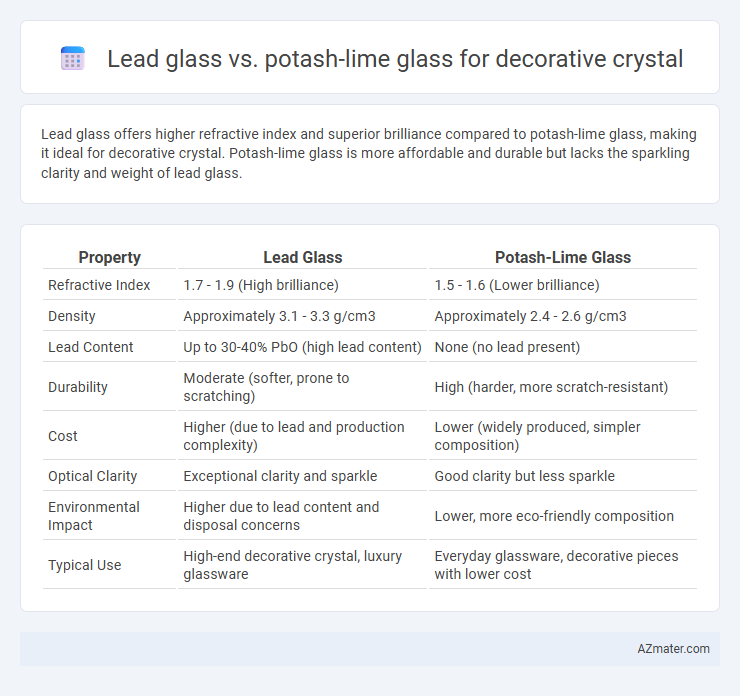Lead glass offers higher refractive index and superior brilliance compared to potash-lime glass, making it ideal for decorative crystal. Potash-lime glass is more affordable and durable but lacks the sparkling clarity and weight of lead glass.
Table of Comparison
| Property | Lead Glass | Potash-Lime Glass |
|---|---|---|
| Refractive Index | 1.7 - 1.9 (High brilliance) | 1.5 - 1.6 (Lower brilliance) |
| Density | Approximately 3.1 - 3.3 g/cm3 | Approximately 2.4 - 2.6 g/cm3 |
| Lead Content | Up to 30-40% PbO (high lead content) | None (no lead present) |
| Durability | Moderate (softer, prone to scratching) | High (harder, more scratch-resistant) |
| Cost | Higher (due to lead and production complexity) | Lower (widely produced, simpler composition) |
| Optical Clarity | Exceptional clarity and sparkle | Good clarity but less sparkle |
| Environmental Impact | Higher due to lead content and disposal concerns | Lower, more eco-friendly composition |
| Typical Use | High-end decorative crystal, luxury glassware | Everyday glassware, decorative pieces with lower cost |
Introduction to Decorative Crystal Glass Types
Lead glass offers exceptional clarity and brilliance due to its high lead oxide content, making it ideal for premium decorative crystal applications. Potash-lime glass, with lower lead content and enhanced durability, serves as a more affordable alternative while maintaining substantial optical qualities. Both glass types differ significantly in density, refractive index, and cost, influencing their selection for specific decorative crystal designs.
What is Lead Glass?
Lead glass, also known as lead crystal, is a type of glass that contains a high percentage of lead oxide, typically between 18% and 40%, enhancing its weight, brilliance, and clarity compared to potash-lime glass. This elevated lead content increases the refractive index, giving decorative crystal an exceptional sparkle and making it ideal for luxury glassware and ornamental items. Potash-lime glass, by contrast, has lower density and less brilliance, as it primarily uses potassium or sodium compounds with lime, resulting in a more common, less refractive glass type.
What is Potash-Lime Glass?
Potash-lime glass, commonly used in decorative crystal, is a type of soda-lime glass enriched with potassium oxide, which enhances its clarity and brilliance. Compared to lead glass, potash-lime glass offers a more environmentally friendly alternative due to the absence of lead while still providing excellent refractive properties suitable for ornamental pieces. Its balanced composition makes it ideal for creating vibrant and durable decorative items without compromising on aesthetic appeal.
Chemical Composition: Lead Glass vs Potash-Lime Glass
Lead glass contains typically 18-40% lead oxide (PbO), significantly increasing its refractive index and density, enhancing brilliance and clarity ideal for decorative crystal applications. Potash-lime glass predominantly consists of silica (SiO2), potash (K2O), and lime (CaO), offering lower density and refractive index compared to lead glass, resulting in less sparkle and weight. The distinct chemical compositions impact optical properties, with lead oxide providing improved light dispersion and brilliance not achievable by potash-lime glass formulations.
Visual Clarity and Sparkle Comparison
Lead glass contains a higher refractive index (around 1.7 to 1.8) compared to potash-lime glass (approximately 1.5), resulting in superior visual clarity and brilliance in decorative crystal. The presence of lead oxide enhances light dispersion, creating a distinctive sparkle and prismatic effect unmatched by potash-lime glass. Potash-lime glass, while more affordable and durable, exhibits lower clarity and less intense sparkle, making it less favorable for high-end decorative crystal applications.
Weight and Density Distinctions
Lead glass exhibits a higher density, typically around 3.1 to 4.0 g/cm3, due to its substantial lead oxide content, making it noticeably heavier than potash-lime glass, which has a density near 2.4 g/cm3. This increased weight in lead glass enhances its refractive index and brilliance, qualities prized in decorative crystal applications. Potash-lime glass, being lighter, is preferred when weight reduction and cost efficiency are prioritized over optical performance.
Workability and Crafting Differences
Lead glass offers superior workability for decorative crystal due to its lower melting point and higher density, allowing artisans to achieve intricate designs and a brilliant finish with ease. Potash-lime glass, while more durable and less costly, has a higher melting point and a harder texture, making it less malleable and more challenging to craft into detailed shapes. The choice between lead glass and potash-lime glass significantly impacts the finesse and complexity achievable in handcrafted decorative crystal pieces.
Durability and Longevity Factors
Lead glass offers superior clarity and brilliance due to its high refractive index, but it is softer and more prone to scratches and chips compared to potash-lime glass. Potash-lime glass demonstrates greater durability and resistance to everyday wear, making it more suitable for decorative crystal items intended for long-term use. The enhanced toughness of potash-lime glass contributes significantly to the longevity of decorative crystal products, maintaining aesthetic appeal over extended periods.
Health and Environmental Concerns
Lead glass contains lead oxide, which raises significant health concerns due to potential lead leaching, especially when used in drinkware or food-related decorative items. Potash-lime glass offers a safer alternative by eliminating harmful heavy metals, reducing toxicity risks and environmental pollution during production and disposal. The shift towards potash-lime glass supports sustainability efforts by minimizing hazardous waste and promoting safer recycling processes in decorative crystal manufacturing.
Choosing the Best Glass for Decorative Crystal Applications
Lead glass offers superior clarity, brilliance, and weight, making it the preferred choice for high-end decorative crystal applications where visual appeal and luxury are paramount. Potash-lime glass, while more affordable and environmentally friendly, lacks the refractive index and density of lead glass, resulting in less sparkle and heft. Selecting the best glass depends on balancing budget constraints with desired optical performance and durability in decorative crystal designs.

Infographic: Lead glass vs Potash-lime glass for Decorative crystal
 azmater.com
azmater.com